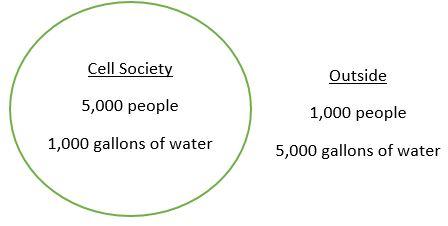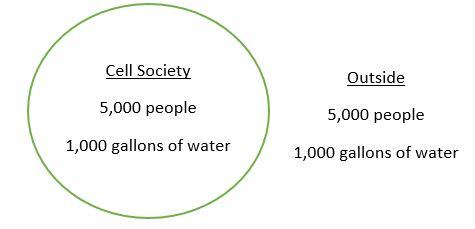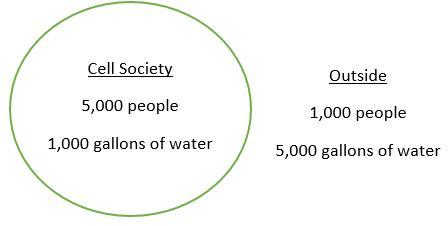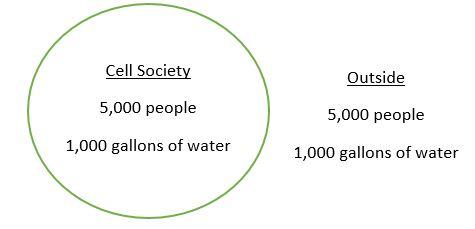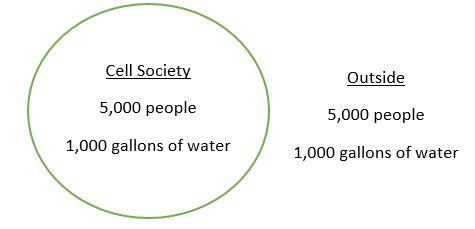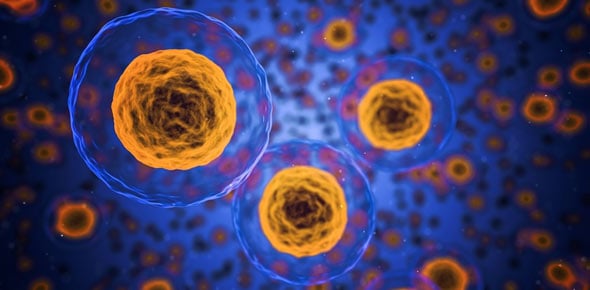Cell Society Diffusion Dilemma And Water Shortage Quiz
-
When your cell society becomes crowded with people (more people inside than outside), which direction would most people want to move (without using energy)?
-
Inside the cell
-
Outside the cell
-
Option 3
-
Option 4
-
Explore key cellular processes in this quiz! Understand active transport, osmosis, and water movement in cells. Assess how solute concentration affects water movement, enhancing your grasp of cell behavior in different environments.

Quiz Preview
- 2.
Which of these needs energy in order to happen?
-
Passive Diffusion
-
Active Transport
-
Osmosis
-
Option 4
Correct Answer
A. Active TransportExplanation
Active transport requires energy in order to happen. Passive diffusion and osmosis, on the other hand, do not require energy. Active transport is a process in which molecules or ions move across a cell membrane against their concentration gradient, from an area of lower concentration to an area of higher concentration. This movement is facilitated by specific transport proteins called pumps, which require energy in the form of ATP to actively transport substances across the membrane.Rate this question:
-
- 3.
What is it called when people (or solutes) move from low concentration to high concentration?
-
Passive Diffusion
-
Active Transport
-
Osmosis
Correct Answer
A. Active TransportExplanation
Active transport is the correct answer because it refers to the process in which solutes or particles move from an area of low concentration to an area of high concentration. This process requires the expenditure of energy by the cell or organism to transport molecules against the concentration gradient. Unlike passive diffusion, which occurs without the need for energy, active transport is a vital mechanism for maintaining homeostasis and ensuring the proper functioning of cells. Osmosis, on the other hand, refers specifically to the movement of water molecules across a semi-permeable membrane.Rate this question:
-
- 4.
What is the movement of water called?
-
Passive Diffusion
-
Active Transport
-
Osmosis
-
Option 4
Correct Answer
A. OsmosisExplanation
Osmosis is the movement of water across a semi-permeable membrane from an area of lower solute concentration to an area of higher solute concentration. It is a passive process that does not require energy. In osmosis, water molecules move in order to equalize the concentration of solute on both sides of the membrane. This process is important for maintaining the balance of water and solutes in cells and tissues.Rate this question:
-
- 5.
Using this situation, is the outside hypertonic, hypotonic, or isotonic compared to the cell? (remember to look at the number of people)
-
Hypertonic
-
Hypotonic
-
Isotonic
Correct Answer
A. HypotonicExplanation
The given answer is "Hypotonic" because the question mentions "Using this situation" which implies that there is a situation described in the previous context. However, since the context is not provided, it is not possible to determine the specific reason why the outside is hypotonic compared to the cell.Rate this question:
-
- 6.
Using this situation, what will happen to the cell after the water moves through osmosis?
-
The cell will shrink
-
The cell will swell/burst
-
The cell will stay the same
Correct Answer
A. The cell will swell/burst -
- 7.
Using this situation, what would happen to the cell?
-
The cell would shrink
-
The cell would swell
-
The cell would stay the same
Correct Answer
A. The cell would stay the sameExplanation
The given answer states that the cell would stay the same. This implies that there would be no change in the size or volume of the cell. It suggests that the situation described does not have any effect on the cell's size or shape.Rate this question:
-
- 8.
Using this situation, which direction will the water move?
-
Inside the cell
-
Outside the cell
-
Both inside and outside
Correct Answer
A. Inside the cellExplanation
When the question mentions "using this situation," it implies that there is a specific situation being referred to, although it is not explicitly mentioned. In general, water moves inside the cell when there is a higher concentration of solutes (such as salts or sugars) inside the cell compared to outside. This creates a concentration gradient, causing water to move from an area of lower solute concentration (outside the cell) to an area of higher solute concentration (inside the cell) through a process called osmosis. Therefore, the correct answer is "Inside the cell."Rate this question:
-
- 9.
Using this situation, is the outside solution hypertonic, hypotonic, or isotonic compared to the cell?
-
Hypertonic
-
Hypotonic
-
Isotonic
Correct Answer
A. IsotonicExplanation
The outside solution is isotonic compared to the cell because it has the same concentration of solutes as the cell. In an isotonic solution, there is no net movement of water across the cell membrane, resulting in a stable cell volume.Rate this question:
-
- 10.
Using this situation, what direction will water move through osmosis?
-
Inside the cell
-
Outside the cell
-
Both inside and outside
Correct Answer
A. Both inside and outsideExplanation
Osmosis is the movement of water molecules across a semi-permeable membrane from an area of lower solute concentration to an area of higher solute concentration. In this situation, water will move both inside and outside the cell through osmosis. If the solute concentration is higher inside the cell compared to the surrounding environment, water will move from outside the cell to inside, causing the cell to swell. Conversely, if the solute concentration is higher outside the cell, water will move from inside the cell to outside, causing the cell to shrink. Therefore, osmosis can occur in both directions depending on the relative solute concentrations.Rate this question:
-
- 11.
Starfish cells are used to being in very salty water. Star fish cells normally have high concentrations of salt. What would happen to the star fish cells if we put the starfish in fresh water (low concentration of salt).
-
The fresh water is hypertonic to the starfish cells, so the cells would shrink
-
The fresh water is hypotonic to the starfish cells, so the cells would shrink
-
The fresh water is hypertonic to the starfish cells, so the cells would swell/burst
-
The fresh water is hypotonic to the starfish cells, so the cells would swell/burst
Correct Answer
A. The fresh water is hypotonic to the starfish cells, so the cells would swell/burstExplanation
Since the starfish cells have lots of salt and the freshwater has a low concentration of salt, that means the freshwater is hypotonic to the starfish cells. Hypo= Low. Whenever cells are in hypotonic solutions, water goes into the cell and makes the cell swell.Rate this question:
-
Quiz Review Timeline (Updated): Mar 14, 2023 +
Our quizzes are rigorously reviewed, monitored and continuously updated by our expert board to maintain accuracy, relevance, and timeliness.
-
Current Version
-
Mar 14, 2023Quiz Edited by
ProProfs Editorial Team -
Jan 11, 2017Quiz Created by
Bingmanl
Advanced Science: Diffusion And Osmosis Quiz (2nd Trimester, 2014-2015)
This Advanced Science quiz for the 2nd Trimester of 2014-2015 focuses on key concepts of diffusion and osmosis. It tests understanding of molecular movement, cell membrane...
Questions:
20 |
Attempts:
426 |
Last updated:
Mar 22, 2023
|
Water Molecule Chapter 8 Quiz Questions
This 'Water Molecule Chapter 8' quiz assesses understanding of diffusion, osmosis, and cellular responses in different osmotic conditions. It evaluates key skills in predicting...
Questions:
18 |
Attempts:
177 |
Last updated:
Oct 18, 2024
|
Osmosis Quiz Questions And Answers
Do you know about the process of osmosis? Then, you must take this osmosis quiz to check your knowledge regarding the same. Osmosis involves transferring water from a less...
Questions:
10 |
Attempts:
23532 |
Last updated:
Nov 11, 2024
|
10th Grade Biology With Lab: Osmosis And Diffusion.
Both osmosis and diffusion as we have come to learn involves the transfer of water and particles from one area to another area. The transfer depends on the level of...
Questions:
22 |
Attempts:
1441 |
Last updated:
May 20, 2025
|
Do You Know Fibrin?
Fibrin is an important substance involved in blood clotting. It is a fibrous, non-globular protein that can be obtained from animal sources and glycosylated with glycans.
Questions:
10 |
Attempts:
169 |
Last updated:
Mar 21, 2023
|
Physiology Week 4 Quiz
This quiz covers key physiological concepts including cellular processes and fluid balance, assessing understanding of homeostatic mechanisms, ion concentrations, and membrane...
Questions:
24 |
Attempts:
288 |
Last updated:
Mar 21, 2023
|
 Back to top
Back to top




